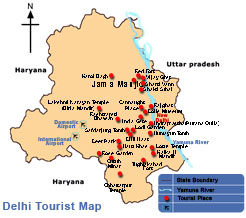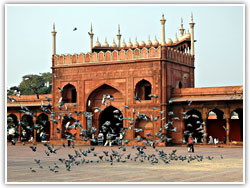|
|
About Delhi
.............................................................................................................................................................................. |
|
|
|
General Information about Delhi
Altitude: 216 m.
Area: 483 sq km.
Best season: October to March
People: Hindu, Sikhs, Muslims, Tibetans,
Ladakhis and Kashmiris
Information about Delhi
Delhi, a city that existed for about two thousand
years is the modern cosmopolitan and capital city
of India. New Delhi is the capital of India and a
Union Territory. It is one of the most famous
tourist destination, seat of the Parliament, the
Supreme Court and the |
 |
 |
Enlarge View |
|
|
President of India and gateway of India. It is one of
the oldest and the newest cities of the world with
various startling contrasts. Various monuments built by
the great Mughal emperors, museums, art galleries,
bazaars and modern shopping areas are situated in this
city. The city boasts of tourism infrastructure which is
one of the best in Asia. This city is one of the most
oriental, a modern, green, political and progressive
city. Delhi is an ideal place to begin one's discovery
of India. The Best season to visit Delhi is from October
to March.
Information about
Modern Delhi
Modern Delhi is the fastest growing large city in India,
rapidly overtaking the colonial cities of Bombay and
Calcutta in sheer size, and ling since eclipsing them in
political importance. The first impressions for any
first time visitor traveling in from the airport are of
a specious, garden city, tree-lined and with a number of
beautiful parks, which in the winter are packed with
colour. Many different regional and religious sub-groups
make up the rapidly growing population. The turbaned
Sikhs, colorfully dressed Rajasthani and Gujarati women
working as manual laborers on building sites, Muslim
shopkeepers along Chandni Chowk in Old Delhi, Tibetans
and Ladakhis in the street stalls along Janpath, and
Kashmiris in the handicraft emporia around Connaught
Place, all add to the cosmopolitan feel of the city, a
microcosm of India itself. Khushwant Singh, one of
India’s foremost journalists and novelists, has noted
that Delhi’s charm depends on a suitable combination of
season, time of day, weather and mood, which can
transform a casual street scene or an inconspicuous
tomb. |
|
|
|
Architecture of Delhi - Old & New Delhi
The age of the Delhi cannot be known today. But,
some of the stone inscriptions, Buddhist and Jain
scriptures, earthenware and pottery found here
describes that it belongs to the 3,000 B C. There
is also difference in the opinion of the
historians regarding the number of cities built by
different rulers over hundreds of years. According
to some people there were only 7 cities while as
per others there were only 15. But now, the ruins
of only seven cities are present. In the
Mahabharata, the |
 |
|
|
great
epic, Delhi was known as Indraprastha which was found by
the Pandavas on the banks of the Yamuna river. In the
11th century A D, Raja Anangpal of Kanauj, established
Lalkot as his capital inside the present day Qutub Minar
area. Historically, this was the first city of Delhi and
ruins of this city are still present. Anangpal’s
successors ruled from it for almost a century until
Vishaldeva, conquered it. In the end of the 12th
century, Mohammad Ghori came to Delhi and defeated
Prithviraj Chauhan and occupied Delhi. He did not make
Delhi his home and left his new kingdom in the hands of
Allauddin Khilji. Lalkot was the Khilji’s capital until
he built a new capital after defeating the invading
Rajputs at Siri where he built his own capital in 1303.
The city of Tughlaqabad, which took about four years to
built, was built by Ghyas-ud-din Tughlaq and was
abandoned due to scarcity of water. Due to this, his son
Mohammad, built another capital, Jahanpanah, quite close
to the Qutab Minar. Delhi's fifth city, Ferozabad was
founded by Feroz Shah Tughlaq in the Ferozshah Kotla
area. Delhi’s sixty city was founded by Emperor Humayun
between 1533 and 1534 AD in the old Indraprastha site,
where the Purana Quila is situated. Later this city was
ruled by the Sher Shah Suri. Sher Shah Suri built a
beautiful hall and a mosque in the old Fort and the
Grand Trunk Road. He ruled from Delhi till 1555 until
the Humayun recaptured it and returned to power.
Shahjahanabad also known as the Old Delhi, was built by
the Emperor Shah Jahan as Delhi’s seventh city between
1638 and 1649. The main monument of the old Delhi is the
magnificent Red Fort, built of red sandstone and Jama
Masjid and the Chandni Chowk, the famous market of the
Mughals. New Delhi, the Delhi’s eighth city, was
developed by the British in the 20th century. Sir Edward
Lutyens and Sir Herbert Baker, the two famous British
architects were commissioned to design the new capital.
In 1911, the Britishers decided to move the capital to a
more central place and selected Delhi as the city was
the nation’s capital for several centuries. They
designed the city of New Delhi to reflect the power and
glory of the British Empire and Hindu, Muslim and
European architecture with the scope for expansion so
that it can accommodate 70,000 people. In 1931, the New
Delhi was formally inaugurated as the capital of India.
The main places in the New Delhi are the Rajpath, India
Gate, President House, Rashtrapati Bhawan, Secretariat
buildings, Old Fort and the Humayun Tomb. |
|
|
|
Climate of Delhi
The monsoon lasts from mid-June to mid-September. May
and June are very hot and dry. The best season to visit
Delhi is from October to March. December and January can
be colder than most people realize, particularly at
night, so woolens are recommended.
Festivals of Delhi
Delhi is a land of festivals. Some festivals celebrated
in Delhi are Lohri, Republic day, Beating the Retreat,
Basant Panchami, Holi, Raksha Bandhan, Gandhi Jayanti,
Diwali and Christmas. Lohri, the climax of winter is
celebrated with bonfires and singing. Republic day
Parade on Raj Path is a spectacular fly past and
military march past, with colourful pageants and
tableaux from every state, dances and music. It is
possible to see the full dress preview free, usually two
days in advance. It is a week long celebrations during
which Government buildings are illuminated. Beating the
Retreat at Vijay Chowk, a stirring display by the armed
forces bands marks the end of the Republic Day
Celebration. Holi, the festival of colours, marks the
climax of spring. People throw coloured powder and water
at each other. Diwali is the festival of lights and
fireworks displays.
More....
Tourist Attractions in Delhi
The main tourist attraction in Delhi are Red Fort, Qutub
Minar, Jama Masjid, Humayun Tomb, Lotus Temple, Lakshmi
Narayan or Birla Temple, India Gate and various
Government Buildings in New Delhi area like Rajpath,
Parliament House, Rashtrapati Bhawan, etc. The Red Fort
is built of red sandstone. It is the Delhi's most
magnificent monument, which was built by Emperor Shah
Jahan in 1648. Jama Masjid is the largest mosque in
India, and stands across the road from the Red Fort.
Built in 1656, it is an eloquent reminder of the Mughal
religious fervour. "Qutub Minar" is 71 meter high
and consists of five stories. In 1199 work began on this
tower which was intended to be the most glorious tower
of victory in the world.
Shopping in Delhi
Delhi is a shopper’s paradise and as such shopping here
is an unforgettable experience for the travelers. The
shopping in Delhi is very unique, as the visitor can
visit the modern air-conditioned stores and the
traditional shops where the artisan himself is often
present to explain the intricacies of the craft. The
city of Delhi attracted the craftsmen who created
various masterpieces that would assure them royal
patronage. Now, as the Mughals have gone, but the
craftsmen have passed on their talent to the further
generations, making Delhi the show-window of India’s
craftsmanship. Delhi is the home of some of India’s
finest designers who blended the traditional styles with
the latest international trend to create garments,
sarees, jewellery, silk, brass, carpets and pearls that
find place in some of the most prestigious stores in all
over the world. The Central Cottage industries emporium,
the State Government emporium are the famous shops for
the Indian handicrafts. These government-owned
air-conditioned emporiums offers an unbelievable variety
of textiles, leather, jewellery, carpets, ceramics and
furniture at very reasonable prices. Delhi’s gold and
silversmiths are well known all over the country and due
to this an entire street in Old Delhi is known as the
Chandni Chowk or the ‘Silver Street’. Besides gold and
silver, Delhi offers a variety of precious gems and
various semi-precious stones like cornelian, garnets,
rubies, emeralds, sapphires and diamonds. Besides
jewellery, the shoppers can also buy the fabric, trendy
readymade garments, antiques and rare objects like
miniatures and bronzes, wood carvings and unusual
household objects, footwear, furniture and furnishings,
carpets and durries, spices and tea and wide range of
fashion accessories.
How to reach Delhi
By Air:
New Delhi is well connected to major metropolitan cities
of India like Bombay, Kolkata and Chennai. It is also
well connected to other cities of India and abroad
through regular flights of Indian Airlines, Jet Airways
and Sahara Airlines.
By Rail:
Various important trains daily run between New Delhi and
other major cities.
By Road:
New Delhi is well connected by road to the various parts
of India. Regular bus service operates between Delhi and
major cities like Jaipur, Agra and rest of the cities in
India. |
|